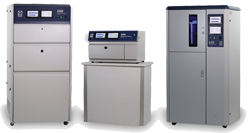耐候性試驗(yàn)
Weathering Testing
咨詢熱線
18566398802ASTM D5796-2010
ASTM D5796-2010標(biāo)準(zhǔn)介紹
ASTM D5796用鉆孔裝置進(jìn)行破壞法測量薄膜涂覆系統(tǒng)的干膜厚度的標(biāo)準(zhǔn)試驗(yàn)方法
ASTM D5796-2010發(fā)行信息
標(biāo)準(zhǔn)號 ASTM D5796-2010
中文名 用鉆孔裝置進(jìn)行破壞法測量薄膜涂覆系統(tǒng)的干膜厚度的標(biāo)準(zhǔn)試驗(yàn)方法
英文名 Standard Test Method for Measurement of Dry Film Thickness of Thin Film Coil-Coated Systems by Destructive Means Using a Boring Device
發(fā)布日期2010
實(shí)施日期
廢止日期無
中國標(biāo)準(zhǔn)分類號A29
國際標(biāo)準(zhǔn)分類號17.040.20
發(fā)布單位US-ASTM
ASTM D5796-2010適用范圍
Measurement of dry film thickness of organic coatings by physically cutting through the film and optically observing and measuring the thickness offers the advantage of direct measurement as compared with nondestructive means.
Constituent coating layers of an overall thickness of a coating system can usually be measured individually by this test method, provide adhesion between each layer is sufficient. (However, this can be difficult in cases where the primer, topcoat, or multiple coating layers have the same, or very similar, appearance.)
與非破壞性方法相比,通過物理切割薄膜和光學(xué)觀察和測量厚度來測量有機(jī)涂層的干膜厚度具有直接測量的優(yōu)勢。
涂層系統(tǒng)總厚度的組成涂層通常可通過本試驗(yàn)方法單獨(dú)測量,前提是各層之間的附著力足夠。(但是,如果底漆、面漆或多層涂層具有相同或非常相似的外觀,這可能會很困難。)
1.1 This test method covers the measurement of dry film thickness (DFT) of coating films by microscopic observation of a precision-cut, shallow-angle crater bored into the coating film. This crater reveals cross sectional layers appearing as rings, whose width is proportional to the depth of the coating layer(s) and allows for direct calculation of dry film thickness.
1.1.1 The Apparatus, Procedure, and Precision and Bias discussions include Method A and Method B. Method A involves the use of an optical measurement apparatus which is no longer commercially available, but remains a valid method of dry film measurement. Method B is a software driven measurement procedure that supersedes Method A.
1.2 The substrate may be any rigid, metallic material, such as cold-rolled steel, hot-dipped galvanized steel, aluminum, etc. The substrate must be planar with the exception of substrates exhibiting x201C;coil set,x201D; which may be held level by the use of the clamping tool on the drilling device.
Note 18212;Variations in the surface profile of the substrate may result in misrepresentative organic coating thickness readings. This condition may exist over substrates such as hot-dipped, coated steel sheet. This is true of all x201C;precision cutx201D; methods that are used to determine dry film thickness of organic coatings. This is why several measurements across the strip may be useful if substrate surface profile is suspect.
1.3 The range of thickness measurement is 0 to 3.5 mils (0 to 89 x03BC;m).
Note 28212;For DFT measurements of films greater than 3.5 mils (89x03BC;m), but less than 63 mils (1600 x03BC;m), a 45x00B0; borer may be used in accordance with this test method, with the exception of 6.8, where the micrometer reading would provide a direct read-out, and division by ten would be unnecessary per 4.3.1 Method A.
1.4 Measurements may be made on coil-coated sheet, certain formed products, or on test panels.
1.5 The values stated in SI units are to be regarded as the standard. The values given in parentheses are for information only.
1.6 This standard does not purport to address all of the safety concerns, if any, associated with its use. It is the responsibility of the user of this standard to establish appropriate safety and health practices and determine the applicability of regulatory limitations prior to use.
溫馨提醒:本ASTM D5796-2010可能存在更新的版本,建議尋找ASTM D5796-2010的發(fā)行商確認(rèn)。
- 中國汽車工程學(xué)會《汽車零部件及材料實(shí)驗(yàn)室循環(huán)腐...
- Q-SUN氙燈試驗(yàn)箱得到了Ford汽車BO 1...
- 循環(huán)鹽霧腐蝕測試技術(shù)網(wǎng)絡(luò)研討會圓滿結(jié)束...
- 美國Q-lab推出全新的萬能校準(zhǔn)儀...
- 循環(huán)鹽霧腐蝕測試技術(shù)網(wǎng)絡(luò)研討會問題收集與解答...
- 循環(huán)鹽霧腐蝕測試技術(shù)網(wǎng)絡(luò)研討會視頻回放...
- Q-fog鹽霧試驗(yàn)箱錯誤代碼解析...
- Q-fog鹽霧試驗(yàn)箱有哪些安全傳感器...

 粵公網(wǎng)安備 44060402000067號
粵公網(wǎng)安備 44060402000067號